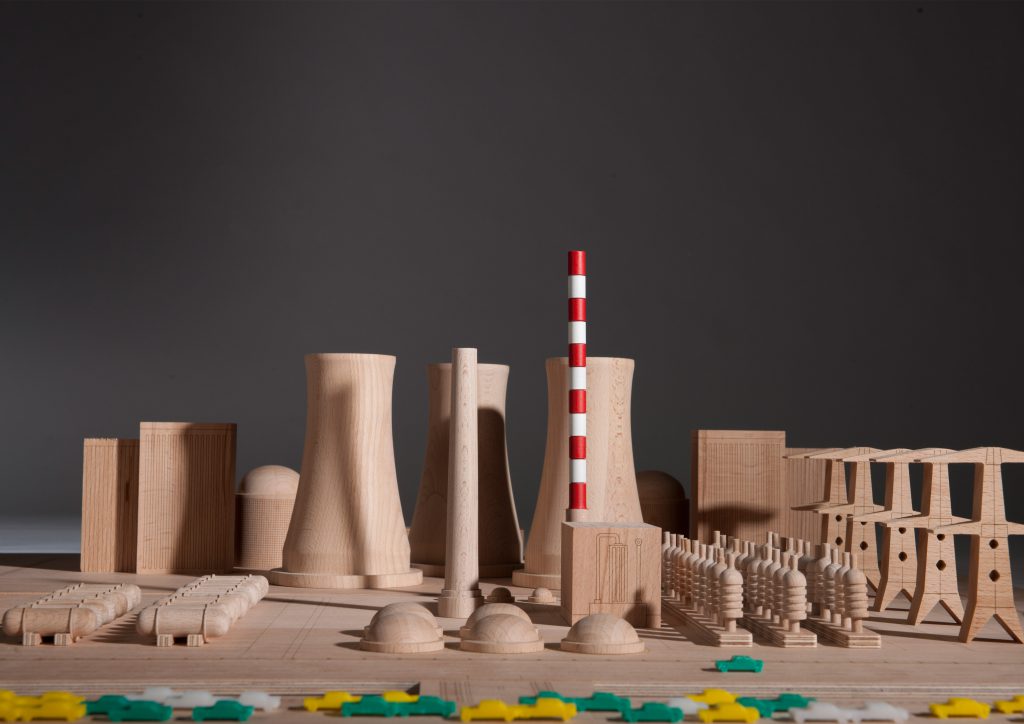Opening of the exhibition
Serious Fun
Architecture & Games

Critical Blocks. A mega farm, a power plant and a highway as toy blocks. For the designer Maykel Roovers these embody essential elements of contemporary architecture and spatial planning. Large scale architecture is rendered abstract with building blocks, emphasising the contrast between the harshness of these urban planning measures and the playful illusory children's world of unlimited possibilities.
© Critical Blocks, Maykel Roovers, 2012
We are all familiar with the classic architecture games, from building blocks that become daring structures to board games where the players compete for spatial-strategic advantages. What are, though, the architecture narratives invested in doll's houses, along which guidelines do cities grow in computer games, and what kind of buildings shield ego-shooters from their assailants? The exhibition 'Serious Fun' shows and examines architecture games and toys, inviting you to be astonished, to play and to reflect.
Architecture games and toys are a part of our cultural and technical heritage. They come made of wood, metal or cardboard, others are played on computers or consoles. Hybrid variations turn the city itself into a gameboard, creating an interface to parallel worlds. These games and toys are a part of social history, too. As a deeply expressive form of popular culture, they convey how we perceive our built environment and different ways of imagining it. Unlike representations with images, which we view from a distance, games can develop a strongly immersive character: Whoever participates in a game becomes part of it himself. This captivating power is not without ambivalence. On the one hand, the miniature scale is inviting, so people can actively participate in the development of buildings, towns or situations that they would never otherwise have had any access to in reality — which has made games popular as a tool in participatory processes. On the other hand, it is the developers who influence or manipulate the course and outcome of the games. Their decisions not only build whole worlds, they also shape world views.
The exhibition presents games and reflections on games. The exhibits, many of which are interactive, were created by architects, artists and game developers. The visitor’s gaze is frequently drawn to specific, sometimes strange but frequently innovative aspects of architecture games. What are the utopias and dystopias that they evoke, what are the values and ideas they convey, criticise or endorse? What kind of places, themes and ways of life are frequently left out, and which games fill these gaps? Visitors can take an alternative city tour through a videogame environment, they can dabble on the virtual London property market, experience doll’s houses as lurid minidramas or emancipatory narratives, stimulate the spatial experience of a blind person in a purely acoustic videogame, or develop eco-friendly city districts in collaboration with others.
The exhibition ‘Serious Fun’ invites visitors to play and to ponder. It provides an opportunity to become immersed in both familiar and in less familiar games, while it also encourages people to take a step back and to take a critical look at the world of games and the constructed worlds that they create. Games can both celebrate and trivialise architecture, they can delimit and they can de-limit whole worlds. They do not only integrate architectural practice, they also hold a mirror up to it.
In cooperation with FOTO WIEN.
Speakers:
Angelika Fitz, Director Az W
Mélanie van der Hoorn, Curator
Curator: Mélanie van der Hoorn
Project coordination Az W: Katharina Ritter
Exhibition design: DWARS ontwerp (Mark Schulte & Miriam de Lange)
